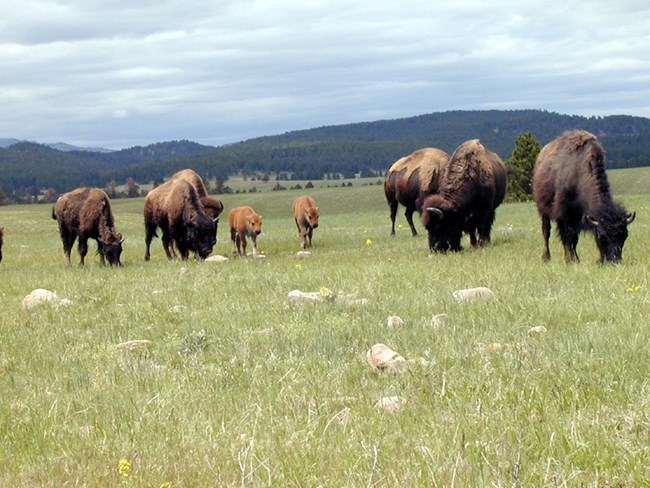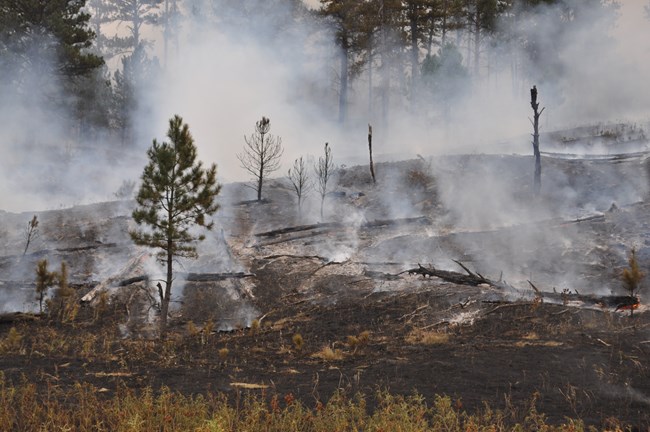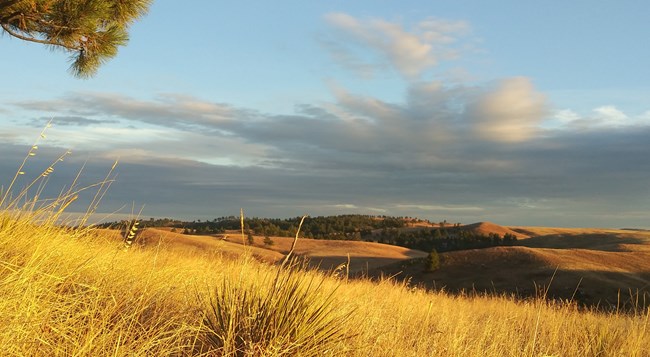
NPS photo The prairie ecosystem is like a puzzle. When parts of the puzzle go missing, it is difficult to understand the complete picture. At Wind Cave, as many parts of this puzzle are preserved as is possible. As a result, this park is a refuge for prairie plants and animals, and a great place to see a remnant of the North American grasslands. 
NPS Photo The prairie is divided into the eastern tall grass prairie, the central mixed grass prairie, and the western short grass prairie. Tall grass prairies receive 30 or more inches of rain per year, while short grass prairies receive about 12 inches of rain. Mixed grass prairie receives rainfall between these amounts. The species composition is determined by the climate, fire frequency, and the degree and frequency of grazing. The mixed grass prairie is an ecotone that results where species composition is constantly shifting between the tall and short grass prairies. 
NPS Photo GrassWith such an extreme environment, it is a wonder that anything can survive. But there is one type of organism that dominates the prairie—grass. Grass provides food and habitat for many species, and covers the prairie. 
NPS Photo AnimalsMany prairie animals rely on prairie grasses for survival. Mammals like prairie dogs, bison, elk, deer, and pronghorn graze on the grasses and other plants that grow on the prairie. Predators like birds of prey, mountain lions, coyotes, and black footed ferrets depend on the abundance of wildlife to hunt for prey. FireTo us humans, fire is often seen as a threat. But fire can be constructive and is a natural part of the prairie environment. In fact, the survival of the prairie depends upon fire. 
NPS photo The suppression of fires in the Black Hills, the area in which Wind Cave is located, has led to higher forest density. This has contributed to the decline in plant diversity, and also contributes to more intense fires when they do occur. Wind Cave National Park routinely conducts prescribed fires. These fires are closely monitored to ensure the health of the environment, but also ensures that human lives and property are protected. 
NPS Photo / Abby Rimstidt ConservationFew ecosystems have seen the destruction endured by the prairie. Prior to European settlement, the prairie was a vast, unbroken stretch of plant and animal communities. With the advent of agriculture in the American west, the prairie became fragmented. Widespread animal and plant declines, and the introduction of invasive species, led to a sharp decline in biodiversity. One example of this is the decline and near extinction of the bison.
Though this park was created to protect a cave system, its national park status was saved from an uncertain future by incorporating a game preserve on the park’s surface. Since 1912, the park’s dual mission was to ensure the survival and health of the prairie habitat which it occupies. Today, it is one of the best places on the continent to experience the mixed-grass prairie. Bison are a common sight here, grazing and wallowing among prairie dog towns. From up high, one can view the mosaic of prairie grasses and wildflowers waving in the wind. One can close their eyes, listening to the wild sounds of the prairie, and imagine that nothing’s changed here for hundreds of years. Solitude is found amongst the wind rushing, birds chattering, bison bellowing, and insects clicking. Here, the pieces of the prairie puzzle are intact. Learn more from other parks... |
Last updated: July 30, 2024
